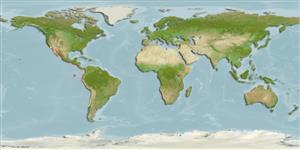Environment: milieu / climate zone / depth range / distribution range
Ecologia
marino associati a barriera corallina; distribuzione batimetrica 3 - 36 m (Ref. 5227). Tropical; 40°N - 50°S, 120°W - 70°W
Eastern Pacific from Baja California to Ecuador. Reported from Peru (Ref. 9276) and Chile (Ref. 9068).
Size / Peso / Age
Maturity: Lm ? range ? - ? cm
Max length : 100.0 cm TL maschio/sesso non determinato; (Ref. 9276); common length : 55.0 cm TL maschio/sesso non determinato; (Ref. 9276)
Short description
Chiavi di identificazione | Morfologia | Morfometria
Body compressed and moderately deep; skin thick, with large, rectilinear, plate-like scales, some of them spiny, that are easily visible to the naked eye; mouth small; teeth strong and protruding, 8 in each jaw; snout with a naked scale-less area behind the jaws; dorsal fin with 3 spines and more than 25 rays; scales located behind the gill openings much larger than the surrounding scales (Ref. 55763).
Found around reefs and over sandy bottoms of shallow waters (Ref. 9276). Feeds on sea urchins, small crustaceans and mollusks, often blowing into sand to uncover prey or turn over urchins (Ref. 5227).
Life cycle and mating behavior
Maturities | Riproduzione | Spawnings | Egg(s) | Fecundities | Larve
Bussing, W.A., 1995. Balistidae. Pejepuercos, calafates, gatillos. p. 905-909. In W. Fischer, F. Krupp, W. Schneider, C. Sommer, K.E. Carpenter and V. Niem (eds.) Guia FAO para Identification de Especies para lo Fines de la Pesca. Pacifico Centro-Oriental. 3 Vols. FAO, Rome. (Ref. 9276)
IUCN Red List Status (Ref. 130435)
Threat to humans
Harmless
Human uses
Strumenti
Special reports
Download XML
Fonti Internet
Estimates based on models
Preferred temperature (Ref.
123201): 20.8 - 26.9, mean 22.6 °C (based on 20 cells).
Phylogenetic diversity index (Ref.
82804): PD
50 = 0.6250 [Uniqueness, from 0.5 = low to 2.0 = high].
Bayesian length-weight: a=0.02570 (0.01232 - 0.05364), b=2.94 (2.77 - 3.11), in cm total length, based on LWR estimates for this (Sub)family-body shape (Ref.
93245).
Trophic level (Ref.
69278): 3.4 ±0.40 se; based on food items.
Resilienza (Ref.
120179): Basso, tempo minimo di raddoppiamento della popolazione 4.5 - 14 anni (Preliminary K or Fecundity.).
Fishing Vulnerability (Ref.
59153): High vulnerability (60 of 100).
Nutrients (Ref.
124155): Calcium = 20.9 [8.5, 47.4] mg/100g; Iron = 0.457 [0.229, 1.005] mg/100g; Protein = 18.6 [16.4, 20.7] %; Omega3 = 0.0892 [, ] g/100g; Selenium = 43.6 [19.0, 92.6] μg/100g; VitaminA = 34.4 [9.2, 123.8] μg/100g; Zinc = 0.83 [0.56, 1.25] mg/100g (wet weight);
